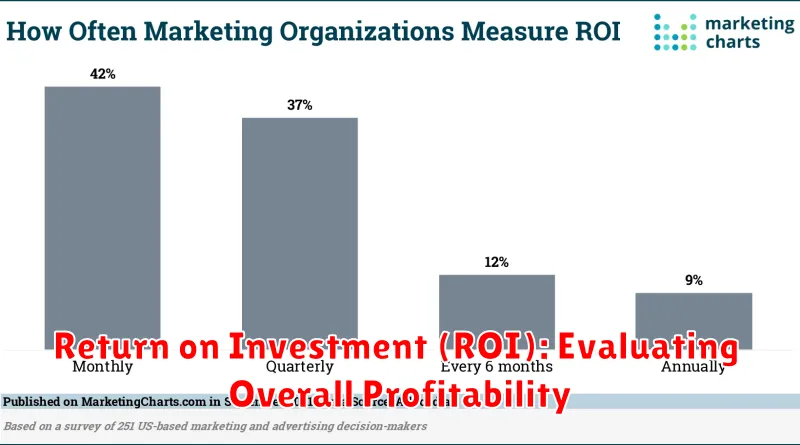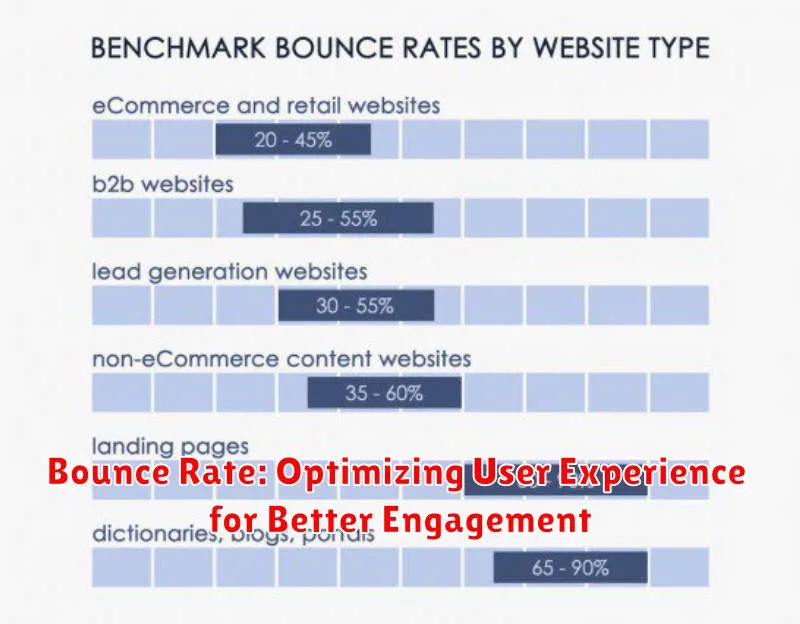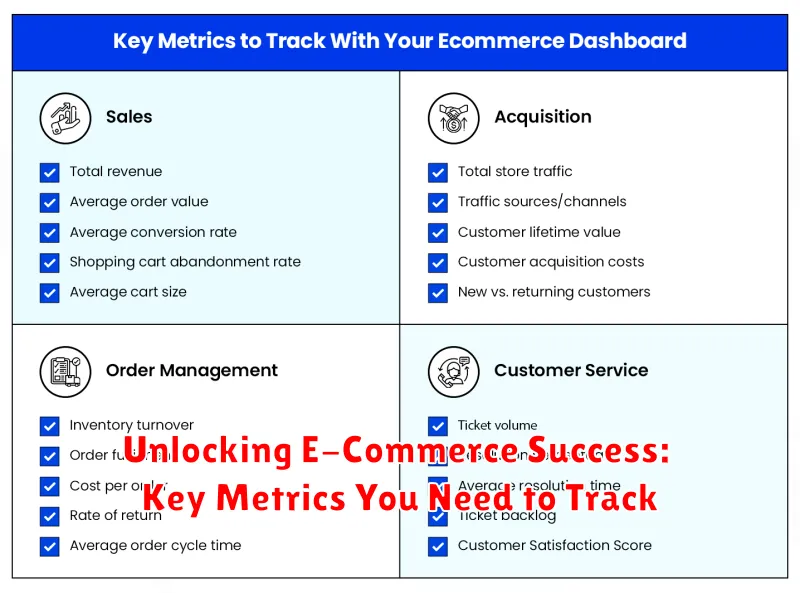In today’s competitive digital landscape, achieving e-commerce success requires more than just an online presence. It demands a deep understanding of your business performance, driven by data-informed decisions. Tracking the right key metrics provides invaluable insights into customer behavior, marketing effectiveness, and overall profitability. This empowers you to optimize strategies, enhance the customer experience, and ultimately unlock your full e-commerce potential. Understanding these key metrics is paramount for driving growth and staying ahead of the curve in the ever-evolving world of e-commerce.
This article will delve into the essential metrics you need to monitor for e-commerce success. We’ll explore key performance indicators (KPIs) ranging from conversion rates and average order value to customer lifetime value and customer acquisition cost. By mastering these e-commerce metrics, you can gain a comprehensive understanding of your business performance and make data-backed decisions to drive sustainable growth and achieve lasting e-commerce success.
Understanding the Importance of E-Commerce Metrics
In the dynamic world of e-commerce, data is king. Tracking and analyzing key metrics is crucial for understanding your business performance, identifying areas for improvement, and ultimately, driving growth and profitability. Without a clear understanding of these metrics, businesses are essentially navigating blind, unable to make informed decisions about marketing, sales, and overall strategy.
E-commerce metrics provide valuable insights into customer behavior, sales trends, and the effectiveness of your marketing campaigns. They offer a quantifiable way to assess the health of your business and identify areas of strength and weakness. By regularly monitoring these metrics, you can make data-driven decisions that optimize your online store for conversions, revenue, and customer satisfaction.
Essentially, e-commerce metrics provide a framework for understanding what’s working, what isn’t, and how to adapt to the ever-changing e-commerce landscape. This data-driven approach empowers businesses to stay ahead of the competition and achieve sustainable success in the digital marketplace.
Conversion Rate: The Ultimate Measure of Success
The conversion rate is arguably the most critical metric for e-commerce businesses. It represents the percentage of website visitors who complete a desired action, typically a purchase. A high conversion rate signifies an effective sales funnel and a positive user experience, while a low rate indicates areas needing improvement.
Calculating your conversion rate is straightforward: divide the number of conversions by the total number of visitors and multiply by 100. For example, if you had 10,000 visitors and 200 sales, your conversion rate is 2%.
Improving your conversion rate involves optimizing various aspects of your online store, including:
- User Experience (UX): A seamless and intuitive website navigation.
- Product Presentation: High-quality images and compelling descriptions.
- Checkout Process: A simple and secure checkout experience.
- Call to Actions (CTAs): Clear and strategically placed CTAs.
By closely monitoring and actively working to improve your conversion rate, you can directly impact your bottom line and achieve sustainable growth.
Average Order Value (AOV): Boosting Your Revenue
Average Order Value (AOV) represents the average amount spent by customers per order. Tracking AOV is crucial for understanding your revenue generation and identifying opportunities for growth. By increasing AOV, you can directly impact your bottom line without necessarily acquiring more customers.
Calculating AOV is straightforward: divide your total revenue by the number of orders. A higher AOV suggests customers are purchasing more items or higher-priced products per transaction.
Several strategies can effectively boost AOV. Cross-selling and upselling are effective techniques. Offering product bundles or volume discounts encourages larger purchases. Free shipping thresholds can also incentivize customers to add more to their cart to reach the free shipping minimum.
Regularly monitoring and analyzing AOV helps optimize pricing strategies, promotional offers, and product bundling to maximize revenue generation.
Customer Lifetime Value (CLTV): Building Long-Term Relationships
Customer Lifetime Value (CLTV) represents the total revenue you can expect from a single customer throughout their relationship with your business. Understanding and maximizing CLTV is crucial for sustainable growth. It shifts the focus from individual transactions to fostering long-term customer loyalty.
Calculating CLTV involves considering factors like average purchase value, purchase frequency, and customer lifespan. By analyzing CLTV, you can identify your most valuable customer segments and tailor your marketing efforts accordingly.
Increasing CLTV involves strategies focused on customer retention and building stronger relationships. Personalized communication, loyalty programs, and exceptional customer service all contribute to a higher CLTV. Investing in strategies to improve CLTV ultimately leads to a more profitable and sustainable business model.
Shopping Cart Abandonment Rate: Identifying and Addressing Pain Points
A high shopping cart abandonment rate can significantly impact your bottom line. This metric represents the percentage of customers who add items to their online shopping cart but leave before completing the purchase. Understanding why customers abandon their carts is crucial for optimizing your checkout process and recovering lost sales.
Several factors contribute to cart abandonment. Unexpected costs, such as high shipping fees or taxes, are a common deterrent. A complicated or lengthy checkout process can also frustrate customers and lead to abandonment. Limited payment options can alienate potential buyers. Security concerns regarding payment information can also cause hesitation.
Addressing these pain points is essential. Offer transparent pricing upfront to avoid surprising customers at checkout. Streamline your checkout process, minimizing the number of steps required. Provide multiple payment options to cater to different preferences. Clearly communicate your security measures to build trust and alleviate concerns. By analyzing your cart abandonment rate and identifying the underlying causes, you can take proactive steps to improve conversions and maximize revenue.
Customer Acquisition Cost (CAC): Measuring the Efficiency of Your Marketing
Customer Acquisition Cost (CAC) is a crucial metric that reveals how much you’re spending to acquire a new customer. It provides valuable insights into the effectiveness of your marketing campaigns and helps optimize your spending for better returns.
Calculating CAC is straightforward. Simply divide your total marketing and sales expenses over a specific period by the number of customers acquired during that same period.
For example, if you spent $5,000 on marketing in a month and acquired 100 new customers, your CAC is $50. A lower CAC generally indicates a more efficient marketing strategy. However, it’s essential to consider CAC in conjunction with other metrics, such as customer lifetime value (CLTV), to gain a comprehensive understanding of your business’s profitability.
Monitoring CAC helps identify areas where you can improve your marketing efficiency. A high CAC might suggest the need to re-evaluate your target audience, refine your messaging, or explore more cost-effective marketing channels.
Net Promoter Score (NPS): Gauging Customer Loyalty and Advocacy
The Net Promoter Score (NPS) is a vital metric for understanding customer loyalty and potential for advocacy. It measures the likelihood of customers recommending your business to others.
Customers are asked a simple question: “On a scale of 0 to 10, how likely are you to recommend [your company] to a friend or colleague?” Responses are then grouped into three categories:
- Promoters (9-10): These are your loyal enthusiasts, likely to drive repeat business and referrals.
- Passives (7-8): Satisfied but not necessarily loyal, they are susceptible to competitive offerings.
- Detractors (0-6): Unhappy customers who may spread negative word-of-mouth.
Your NPS is calculated by subtracting the percentage of Detractors from the percentage of Promoters. A higher NPS generally indicates stronger customer loyalty and a greater likelihood of positive word-of-mouth marketing.
Tracking NPS over time allows you to monitor the impact of changes in your business strategy, customer service, and product offerings on customer loyalty.
Return on Investment (ROI): Evaluating Overall Profitability

Return on Investment (ROI) is a crucial metric for evaluating the overall profitability of your e-commerce business. It measures the efficiency with which your investments generate profit. A high ROI indicates that your investments are paying off, while a low ROI suggests a need for adjustments.
Calculating ROI involves comparing your net profit to your total investment. The basic formula is: (Net Profit / Total Investment) x 100.
For example, if you invest $1,000 in a marketing campaign and generate $3,000 in profit, your ROI is ($3,000 / $1,000) x 100 = 300%.
Tracking ROI helps you understand which investments are contributing most significantly to your bottom line and allows for data-driven decisions regarding future resource allocation. By consistently monitoring ROI, you can optimize your spending and maximize profitability.
Bounce Rate: Optimizing User Experience for Better Engagement

A bounce rate represents the percentage of visitors who enter your website and leave without interacting further. A high bounce rate can signal issues with user experience, content relevance, or technical problems. Optimizing this metric is crucial for improving engagement and conversions.
Several factors contribute to a high bounce rate. Slow loading times can frustrate users and lead them to abandon your site. Similarly, poor site navigation can make it difficult for visitors to find what they’re looking for. Misleading content that doesn’t align with user expectations also contributes to bounces.
To lower your bounce rate, focus on enhancing the user experience. Ensure your website is mobile-friendly and loads quickly. Implement clear and intuitive navigation. Provide relevant and engaging content that aligns with user search intent. Targeted landing pages can also improve the user experience and reduce bounce rate.
By analyzing your bounce rate and taking steps to improve it, you can create a more engaging online experience that encourages visitors to explore your site and ultimately convert into customers. Regular monitoring and optimization are key to long-term success.

